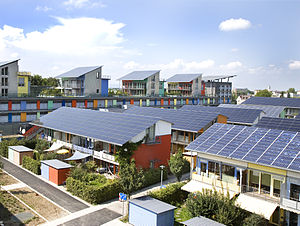Green homes, a totally attainable and attempts of future, are best known for optimising the use of energy, building material and water resources compared to any standard home. They tend to be comparatively efficient and generate less waste.
In short, they are directly proportional to the ideology of saving the environment and reducing the operational costs for the residents in true love of Nature.
A green home is thus designed to be environmentally sustainable because it utilises sustainable energy sources such as solar or geothermal and makes maximum advantage of natural features such as sunlight and tree cover to improve energy efficiency.
Sustainable energy is only extracted by meeting the needs of the present without compromising the ability of future generations to meet their own needs.
Can a normal home be converted to a Green home?
Any house can be remodeled in order to conserve energy or water, improve indoor air quality, use sustainable, recycled or used materials and produce less waste in the process.
How it all began?
The green building movement began in the 1970s, first in US. Researchers made such more energy efficient systems after the price of oil began to increase sharply.
This led to economically-stable as well as sustainable homes.
Green Homes vision in India
According to GOI’s report, as of July 2019, 8.36 million houses have been sanctioned under the government’s “Housing for All by 2022” initiative.
Construction for 4.9 million units has begun and 2.6 million units of which have been completed.
Given the past trend, additional 1.64 million houses are likely to be sanctioned by December 2019, making it highly possible to achieve the 10 million houses target by 2022.

With the ever increasing Urbanisation in India as stated by the U.N. World Urbanization Prospects 2018 report, about 34% of India’s population now lives in urban areas. This is an increase of about three percentage points since the 2011 Census.
Also Buildings account for almost 40% of India’s overall energy consumption, and more than 60% of all buildings being developed in the country are residential projects in India.
Based on this urgent need along with far-fetched green economy envisage, The Indian Green Building Council (IGBC) has set up the IGBC Green Homes, a rating system developed in India for sustainable practices in the residential sector.
Another Indian rating system GRIHA (Green Rating for Integrated Habitat Assessment) is India’s National Rating System for green buildings.
These are consensus-based system aimed at facilitating the effective use of site resources, water conservation, energy efficiency, handling of household waste, optimum material utilisation and design for healthy, comfortable and environmentally friendly homes.
Affordable and green housing is a high potential segment that the private development companies are yet to explore to its potential.
According to India Energy Outlook, GRIHA buildings are now spread over 565 million sqft across the country.
Characteristics/techniques of a Green home:
1. Location: To be made at locations in no contention with environment or disruption to wildlife. It optimises the use of natural resources such as air and sun.
2. Materials: The raw materials must stand the test of the three Rs – Reduce, Reuse, and Recycle; be locally sourced and non-toxic to reduce environmental impact.
Further, the homes can be able to produce renewable energy, for instance, with the use of Photovoltaic Cells (solar energy) to reduce electricity consumption.
3. Design: strategic insulation, natural light, ample aeration and ventilation, green roofs or vertical gardens that helps degrade the pollutants and enhance the air quality around the structure.
4. Energy efficient appliances in use
5. Efficient Water usage: with water-conserving irrigation system, or a rainwater harvesting system.
Are Green homes pricey or economically efficient too?
Green buildings are priced a bit higher than standard buildings. However, Increased durability of materials and lesser maintenance,
reduced operational costs can help recovering the price difference within 2-3 years.
In the longer run, Green homes turn out to be more cost effective.
The Ministry of Environment, Forest and Climate Change (MoEFCC), Government of India, offers speedy environmental clearance for Green building projects which are pre-certified or have a provisional certification by the IGBC.
There are State-level incentives on Floor Area Ratio (FAR) for Green buildings in Punjab, Andhra Pradesh, Uttar Pradesh, Maharashtra, Haryana, Himachal Pradesh and West Bengal, with other States soon to follow suit.
Green building materials such as paints, adhesives, sealants and finishes contain low volatile organic compounds (VOC), so they do not cause respiratory illnesses.
Another gain in disdain where out of pocket health expenditure for additional illness may be avoided.
With unconditional and uncountable benefits and with no current liability, Green Homes are one of the ways we can render our service to the Nation and Nature.




